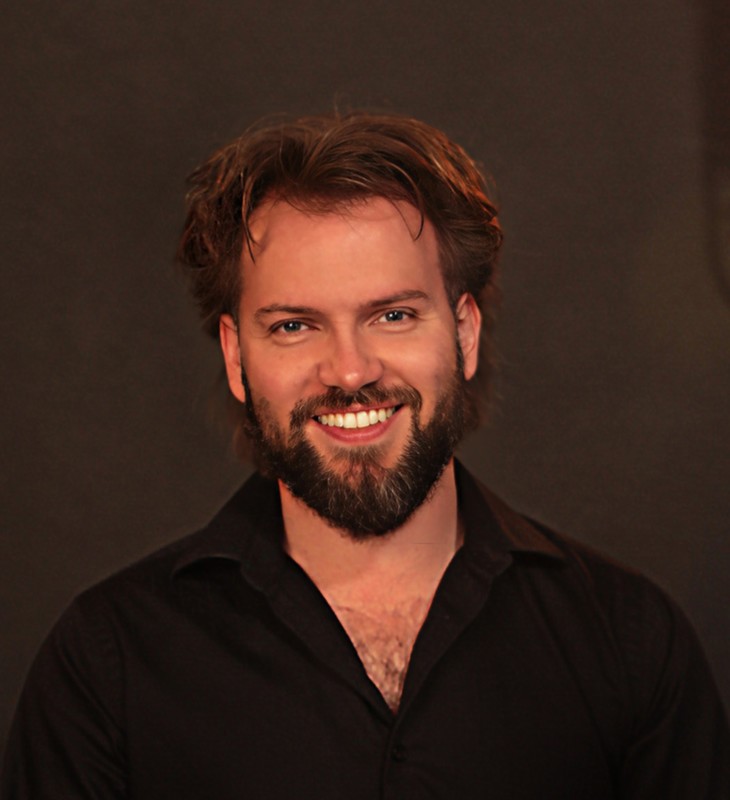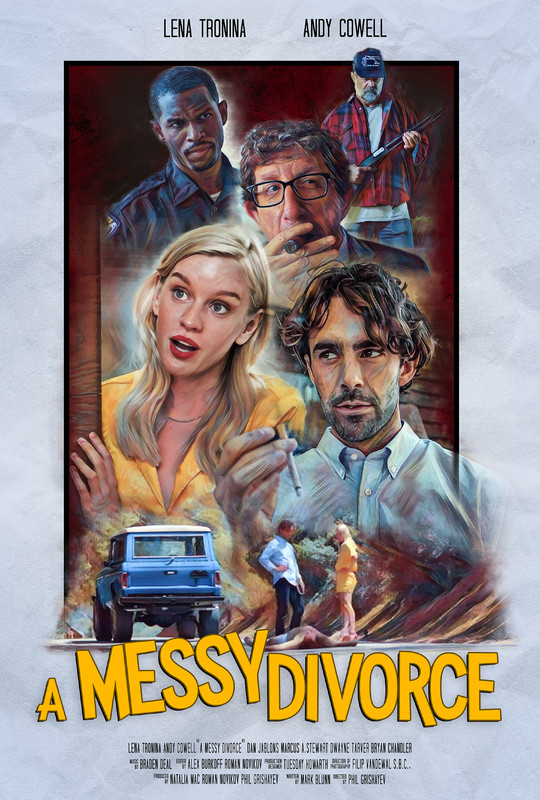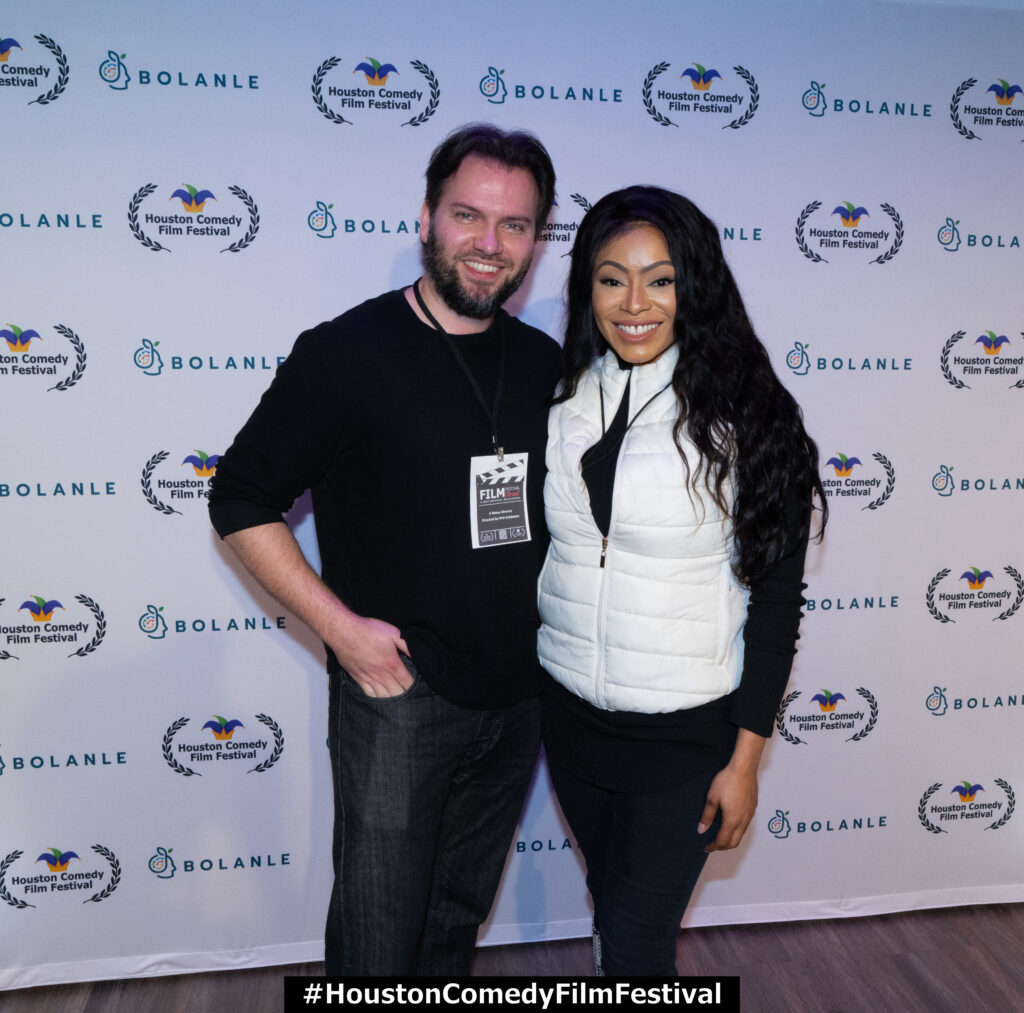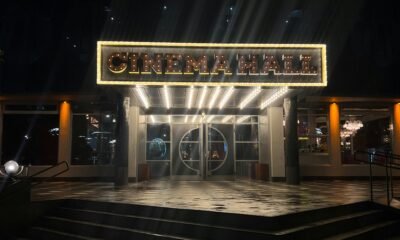Entertainment
“A Messy Divorce” Named Finalist for Best Dark Comedy Film Award

Award Winning Filmmaker, Phil Grishayev
Phil Grishayev, a talented filmmaker based in Los Angeles, is making waves in the comedy film scene with his uproarious short film, “A Messy Divorce.” Born and raised in Poland, Grishayev relocated to the United States in his early twenties, where his passion for storytelling and visual arts blossomed. Despite being relatively new to directing and producing, Grishayev’s creative vision and dedication have propelled him into the spotlight of the entertainment industry.
 “A Messy Divorce” is not only Grishayev’s directorial debut but also a testament to his ability to breathe life into captivating narratives. The film, originally conceived as a screenplay by Grishayev’s friend Lenar Kamalov, follows the misadventures of a newly divorced couple who accidentally run over a man on the road and hilariously attempt to cover up their tracks. With its clever twists and comedic timing, “A Messy Divorce” has earned critical acclaim and audience praise alike.
“A Messy Divorce” is not only Grishayev’s directorial debut but also a testament to his ability to breathe life into captivating narratives. The film, originally conceived as a screenplay by Grishayev’s friend Lenar Kamalov, follows the misadventures of a newly divorced couple who accidentally run over a man on the road and hilariously attempt to cover up their tracks. With its clever twists and comedic timing, “A Messy Divorce” has earned critical acclaim and audience praise alike.
Despite its humble beginnings, “A Messy Divorce” has already achieved notable success in the film festival circuit. Grishayev’s screenplay won a prestigious award at SWN, and the film was selected as an Official Entry at the Houston Comedy Festival in 2021. Now, as a finalist for the Best Dark Comedy Film Award at the esteemed Houston Comedy Film Festival, “A Messy Divorce” continues to captivate audiences with its unique blend of humor and wit.
Looking ahead, Grishayev has ambitious plans to expand “A Messy Divorce” into a full-length feature film, showcasing his commitment to storytelling and filmmaking. With his innovative approach and creative flair, Grishayev is poised to make a lasting impact on the comedy genre and beyond.
As the anticipation builds for the Houston Comedy Film Festival, all eyes are on Phil Grishayev and “A Messy Divorce,” eagerly awaiting the announcement of the winners. In the meantime, audiences can experience the comedic brilliance of Grishayev’s work and witness the rise of a promising filmmaker in the entertainment industry.
He is an incredible Experiential Designer for major Paramount movie premiere sets with films apart of the Barbie franchise and Batman. Check him out here. grishayev.com

Award Winning Filmmaker, Phil Grishayev, and Hollywood Executive Producer and Houston Comedy Film Festival Director, Roselyn Omaka
From the Film Festival Circuit Founder, Mikal Fair:
Entertainment
What We Can Learn Inside 50 Cent’s Explosive Diddy Documentary: 5 Reasons You Should Watch

50 Cent’s new Netflix docuseries about Sean “Diddy” Combs is more than a headline-grabbing exposé; it is a meticulous breakdown of how power, celebrity, and silence can collide in the entertainment industry.
Across its episodes, the series traces Diddy’s rise, the allegations that followed him for years, and the shocking footage and testimonies now forcing a wider cultural reckoning.

1. It Chronicles Diddy’s Rise and Fall – And How Power Warps Reality
The docuseries follows Combs from hitmaker and business icon to a figure facing serious criminal conviction and public disgrace, mapping out decades of influence, branding, and behind-the-scenes behavior. Watching that arc shows how money, fame, and industry relationships can shield someone from scrutiny and delay accountability, even as disturbing accusations accumulate.

2. Never-Before-Seen Footage Shows How Narratives Are Managed
Exclusive footage of Diddy in private settings and in the tense days around his legal troubles reveals how carefully celebrity narratives are shaped, even in crisis.
Viewers can learn to question polished statements and recognize that what looks spontaneous in public is often the result of strategy, damage control, and legal calculation.
3. Survivors’ Stories Highlight Patterns of Abuse and Silence
Interviews with alleged victims, former staff, and industry insiders describe patterns of control, fear, and emotional or physical harm that were long whispered about but rarely aired in this detail. Their stories underline how difficult it is to speak out against a powerful figure, teaching viewers why many survivors delay disclosure and why consistent patterns across multiple accounts matter.
4. 50 Cent’s Approach Shows Storytelling as a Tool for Accountability
As executive producer, 50 Cent uses his reputation and platform to push a project that leans into uncomfortable truths rather than protecting industry relationships. The series demonstrates how documentary storytelling can challenge established power structures, elevate marginalized voices, and pressure institutions to respond when traditional systems have failed.
5. The Cultural Backlash Reveals How Society Handles Celebrity Accountability
Reactions to the doc—ranging from people calling it necessary and brave to others dismissing it as a vendetta or smear campaign—expose how emotionally invested audiences can be in defending or condemning a famous figure. Watching that debate unfold helps viewers see how fandom, nostalgia, and bias influence who is believed, and why conversations about “cancel culture” often mask deeper questions about justice and who is considered too powerful to fall.
Entertainment
South Park’s Christmas Episode Delivers the Antichrist

A new Christmas-themed episode of South Park is scheduled to air with a central plot in which Satan is depicted as preparing for the birth of an Antichrist figure. The premise extends a season-long narrative arc that has involved Satan, Donald Trump, and apocalyptic rhetoric, positioning this holiday episode as a culmination of those storylines rather than a stand‑alone concept.
Episode premise and season context
According to published synopses and entertainment coverage, the episode frames the Antichrist as part of a fictional storyline that blends religious symbolism with commentary on politics, media, and cultural fear. This follows earlier Season 28 episodes that introduced ideas about Trump fathering an Antichrist child and tech billionaire Peter Thiel obsessing over prophecy and end‑times narratives. The Christmas setting is presented as a contrast to the darker themes, reflecting the series’ pattern of pairing holiday imagery with controversial subject matter.
Public and political reactions
Coverage notes that some figures connected to Donald Trump’s political orbit have criticized the season’s portrayal of Trump and his allies, describing the show as relying on shock tactics rather than substantive critique. Commentators highlight that these objections are directed more at the depiction of real political figures and the show’s tone than at the specific theology of the Antichrist storyline.
At the time of reporting, there have not been widely reported, detailed statements from major religious leaders focused solely on this Christmas episode, though religion-focused criticism of South Park in general has a long history.
Media and cultural commentary
Entertainment outlets such as The Hollywood Reporter, Entertainment Weekly, Forbes, Slate, and USA Today describe the Antichrist arc as part of South Park’s ongoing use of Trump-era and tech-world politics as material for satire.
Viewer guidance and content advisory
South Park is rated TV‑MA and is intended for adult audiences due to strong language, explicit themes, and frequent use of religious and political satire. Viewers who are sensitive to depictions of Satan, the Antichrist, or parodies involving real political figures may find this episode particularly objectionable, while others may view it as consistent with the show’s long‑running approach to controversial topics. As with previous episodes, individual responses are likely to vary widely, and the episode is best understood as part of an ongoing satirical series rather than a factual or theological statement.
Entertainment
Sydney Sweeney Finally Confronts the Plastic Surgery Rumors

Sydney Sweeney has decided she is finished watching strangers on the internet treat her face like a forensic project. After years of side‑by‑side screenshots, “then vs now” TikToks, and long comment threads wondering what work she has supposedly had done, the actor is now addressing the plastic surgery rumors directly—and using them to say something larger about how women are looked at in Hollywood and online.

Growing Up on Camera vs. “Before and After” Culture
Sweeney points out that people are often mistaking normal changes for procedures: she grew up on camera, her roles now come with big‑budget glam teams, and her body has shifted as she has trained, aged, and worked nonstop. Yet every new red‑carpet photo gets folded into a narrative that assumes surgeons, not time, are responsible. Rather than walking through a checklist of what is “real,” she emphasizes how bizarre it is that internet detectives comb through pores, noses, and jawlines as if they are owed an explanation for every contour of a woman’s face.
The Real Problem Isn’t Her Face
By speaking up, Sweeney is redirecting the conversation away from her features and toward the culture that obsesses over them.
She argues that the real issue isn’t whether an actress has had work done, but why audiences feel so entitled to dissect her body as public property in the first place.
For her, the constant speculation is less about curiosity and more about control—another way to tell women what they should look like and punish them when they do not fit. In calling out that dynamic, Sweeney isn’t just defending herself; she is forcing fans and followers to ask why tearing apart someone else’s appearance has become such a popular form of entertainment.

 Entertainment4 weeks ago
Entertainment4 weeks agoColombia’s ‘Doll’ Arrest: Police Say a 23-Year-Old Orchestrated Hits, Including Her Ex’s Murder

 Entertainment4 weeks ago
Entertainment4 weeks agoHow The Grinch Became The Richest Christmas Movie Ever

 Entertainment4 weeks ago
Entertainment4 weeks agoMiley Cyrus Is Engaged to Maxx Morando

 Business3 weeks ago
Business3 weeks agoLuana Lopes Lara: How a 29‑Year‑Old Became the Youngest Self‑Made Woman Billionaire

 Film Industry2 weeks ago
Film Industry2 weeks agoDisney Brings Beloved Characters to ChatGPT After $1 Billion OpenAI Deal

 Entertainment4 weeks ago
Entertainment4 weeks agoMariah Carey’s One Holiday Hit Pays her $3.3 Million a Year

 Film Industry3 weeks ago
Film Industry3 weeks agoNetflix Got Outbid: Paramount Drops a $108 Billion Cash Bomb on Warner Bros.

 Entertainment4 weeks ago
Entertainment4 weeks agoAnne Hathaway Just Turned Her Instagram Bio Into a 2026 Release Calendar







































fitspresso reviews
February 16, 2024 at 12:33 am
I’ve become an eager follower of this stellar website over the past week. The owner clearly pours passion into serving up top-notch content that wows readers. I applaud their dedication and hope they keep up the ace work!
is Gluco Relief real
February 18, 2024 at 10:42 am
Awesome! Its genuinely remarkable post, I have got much clear idea regarding from this post
Do AeroSlim Weight loss work
February 26, 2024 at 1:38 am
Somebody essentially lend a hand to make significantly articles Id state That is the very first time I frequented your website page and up to now I surprised with the research you made to make this actual submit amazing Wonderful task
Fitspresso Reviews
March 5, 2024 at 5:27 am
helloI like your writing very so much proportion we keep up a correspondence extra approximately your post on AOL I need an expert in this space to unravel my problem May be that is you Taking a look forward to see you
Fitspresso
March 5, 2024 at 5:36 pm
helloI really like your writing so a lot share we keep up a correspondence extra approximately your post on AOL I need an expert in this house to unravel my problem May be that is you Taking a look ahead to see you
sumatra slim belly tonic
March 10, 2024 at 8:39 pm
Your posts always make me feel like I’m not alone in my struggles and insecurities Thank you for sharing your own experiences and making me feel understood
puravive
March 17, 2024 at 10:05 am
We just wanted to take a moment to acknowledge all the hard work and effort you’ve been putting in lately. Keep up the amazing job, you’re doing great!
alpilean reviews
March 17, 2024 at 10:57 pm
Your blog is a treasure trove of wisdom and positivity I appreciate how you always seem to know just what your readers need to hear
ikaria lean belly juice
March 18, 2024 at 11:58 am
Your posts always provide me with a new perspective and encourage me to look at things differently Thank you for broadening my horizons
dating tips for ladies
March 19, 2024 at 5:47 pm
Your posts always provide me with a new perspective and encourage me to look at things differently Thank you for broadening my horizons
Richarddiast
April 4, 2024 at 2:09 am
демонтаж москва
https://demontagmoskva.ru/